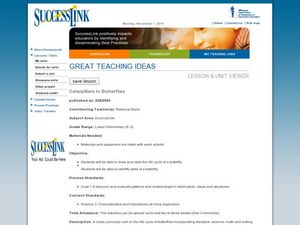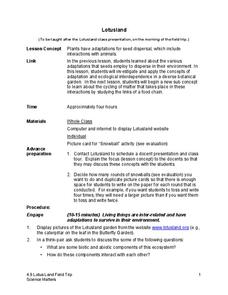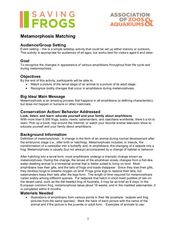Curated OER
Butterfly Lesson
Students identify that Idaho is a home to 168 species of butterflies and they are an important part of many habitats. They also identify how to use the Digital Atlas of Idaho and write a report regarding information of their assigned...
Curated OER
"Caterpillars to Butterflies"
Students participate in a variety of activities about how caterpillers become butterflies.
Curated OER
Miracle of Winged Migration
Students explore the life cycle of insects by researching butterflies. In this insect migration lesson, students identify the Monarch butterfly, where they inhabit, and what their migration consists of. Students utilize the Internet to...
University of Virginia
The Very Hungry Caterpillar
Students engage in a activity that is concerned with the skill of reading comprehension while reading "The Very Hungry Caterpillar" as a class. They read the story while identifying the different types of food with the help of food cards.
Curated OER
Harvesting and Threshing the Seed
Students harvest and thresh the seeds. They count the seeds and compare that number with the original number of seeds planted (8) to determine their profit or loss. Finally, students think about additional questions they have about...
EngageNY
Conducting Research: Asking and Answering our Questions about Rainforest Arthropods
Let's ask an expert. Scholars divide into groups to research and become experts on either ants or butterflies. Learners use task cards and text on their topic to complete a note catcher. At the end, they share their information with a...
Curated OER
What's Happening to Our Caterpillars?
Seventh graders participate in a lesson making observations of caterpillars. They identify different changes in the life cycle of a caterpillar and also understand the final result of the life cycle ending.
Curated OER
Wrap it up!
Sometimes the conclusion of an essay can be the most important part. Whether your writers are ending with a proposition, lesson learned, or persuasive argument, teach them how to "end with a bang" with this helpful PowerPoint! This...
Curated OER
Milkweed Plants
Second graders view milkweed plants (or pictures). The describe the plant and discuss ways some butterflies use it as a food source. Students view four pictures of different phases of a milkweed plant's life cycle. They discuss the...
Curated OER
What Beautiful Caterpillars!
Second graders investigate the life cycle of the caterpillar. They create a caterpillar habitat and care for it. Students make daily observations that are recorded in a writing journal. During the process of observation the students...
Curated OER
What is An Insect?
Students investigate the concept of an insect. They conduct research about six different insects and identify the different body parts. Students look at the life cycle of the developing monarch butterfly. They also use the library to...
Curated OER
The Lepidoptera Project
Students are introduced to Scientific Inquiry and discover how to design an experiment that answers critical questions using butterflies as the topic. They design experiments that compare the number of species of butterflies in a vacant,...
Science Matters
Lotusland
It's time for a field trip! Scholars take their new-found knowledge of adaptations and seed dispersal on a field trip to a local botanical garden. They gain an up-close look at how ecological interdependence works in a distinct...
Curated OER
Caterpillar Habit
Students watch a caterpillar change and become a butterfly. In this lesson about the life cycle of a caterpillar and a butterfly, students prepare and maintain the habitat of the caterpillar. Students observe the stages of the...
Curated OER
If It Smells Good, Is Edible, and Attracts Wildlife, Then It's a Practical Garden
Students explore landscape design. In this practical gardening lesson, students design landscape plans that call for shrubs, trees, and plants that can be used for aesthetics, cooking, and wildlife.
Curated OER
Observing Mealworms and Earthworms
Fifth graders examine the lifecycles of earthworms and mealworms. In groups, they make sketches, measure, and read about mealworms and earthworms. They travel between stations to examine a different part of their lives. To end the lesson...
Curated OER
Metamorphosis Matching
Students view pictures of animals as they complete the metamorphosis from a larva to an adult. In this metamorphosis lesson plan, students view pictures and in the end are able to match pictures of a larva stage to an adult stage in...
Curated OER
Answering Science Questions
Pupils examine the ways in which scientists answer questions. In this critical thinking and scientific process lesson students complete a worksheet of questions.
Curated OER
The Very Hungry Caterpillar
A good book deserves to be followed up by a good worksheet. Here is a great resource which is intended for use after reading The Very Hungry Caterpillar by Eric Carle. It includes several activity ideas that promote skill development in...
Curated OER
How does Temperature Affect Time in the Pupa Stage?
Learners are guided through the Scientific Method to perform observations about the pupa stage of the monarch butterfly. The results of an experiment are used to make assumptions about growth and development.
Curated OER
Adopt-An-Insect Project
Pupils create a school-wide insect collection investigate the insect world. For this project, each grade level "adopts" specific orders of insects, collect specimens, create classroom collections, and complete related activities.
Curated OER
Magnificent Metamorphosis
Students discover stages in metamorphosis through up close and real encounters with video, hands-on investigative and interactive activities using mealworms.
Curated OER
Nature Walk
Students participate in a mini field trip around the neighborhood to observe nature and changes that are occurring during fall. They collect leaves of various colors, shapes and sizes on their trip. Upon return to the classroom, they...
Curated OER
Holy Habitats or Meet Metamorphosis
Students examine the metamorphosis of frogs and how it adapts to its environment. They research how world pollutants are effecting the amphibian population.

























